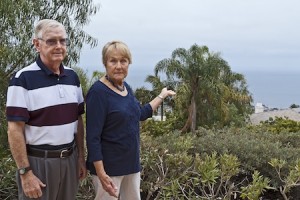
A committee charged with drafting a new view ordinance for Laguna Beach modeled on an effective and court-tested one in Rancho Palos Verdes continues to wrestle with provisions they deem unsuitable here.
At its most recent meeting this past Tuesday, where attendance mushroomed to 100 residents, the committee struggled to find consensus over what would serve as a “trigger date,” or the baseline to determine a property’s defensible view.
They were less divided in opposing another Palos Verdes stipulation, which restricts complaints to view obstructions within 1,000 feet of the view-impaired property.
These were two of three topics discussed, selected because they dominated communications by residents with committee members since the last meeting, said the committee chair, Larry Nokes. The third topic addressed views blocked on public property, an issue the committee had yet to investigate fully.
“A lot of people are feeling a little bit rushed,” Nokes said, because the proposed law resonates deeply with the public and involves divergent and competing rights.
“I’m very concerned that we’re moving forward at a helluva pace,” agreed resident Charlotte Maserick. “It’s on a roll that I don’t like.”
Nevertheless, since the City Council asked for a progress report on the measure early in May, the committee expects to present a proposal by May 21, Nokes said.
With that goal in mind, committee members intend to post a revised draft ordinance on the city’s website by Friday, May 10, allowing residents to review it again before the committee reconvenes, Tuesday, May 14.
Subcommittees were created to divvy up the remaining work: Sue Kempf, Morris Skenderian and Nokes will work on the proposal’s language while Susan Whitin, Bob Borthwick and Chris Toy delve into dealing with city-owned trees.
Nokes alone supported the Palos Verdes provision that property owners have the right to preserve and restore views existing “at any time since the lot was created.” Others preferred the date of purchase, the date the ordinance becomes effective or no date at all, instead relying heavily on the judgment of a committee with decision-making authority.
In order to help homeowners restore their views while maintaining the town’s character, Borthwick proposed the date of purchase as the trigger, a suggestion later endorsed by resident Dave Russell, since, “we paid for that view.”
“For me it doesn’t matter when the lot was created,” said Skenderian. “It’s more about view blockage issues that have gotten worse over the past five or 10 years,” he added, since most of the test cases the committee looked at involved lack of vegetation maintenance in recent years.
Whitin, too, opposed a lot creation trigger date as discriminating against newer owners, since 50 percent of the city’s properties have turned over in the last 10 years, she said. She proposed that the yet-to-be established view arbitration committee evaluate each case on its own merits.
“I’m for anything we can do in the ordinance that can address a lot of these situations where people are just not maintaining their vegetation,” said Kempf, who with Skenderian, Whitin and Toy opposed setting a trigger date. “We are here to create a police power that is pretty far reaching,” said Toy.
Committee member Ken Sadler, on the fence over using the purchase date or no date, worried that speculators might take advantage of the ordinance to buy a property with no view, create a view using the ordinance, and then flip the property.
Committee member Roger McErlane rejected using the lot subdivision date as a baseline because Laguna’s development differs substantially from Palos Verdes, a planned community. He also rejected establishing a view baseline as the date of purchase because he doubted the veracity of photos that can be easily altered.
He earned a few groans from the audience in suggesting that the date the ordinance is passed is a more equitable baseline.
Nearly the entire committee agreed with Nokes’ pronouncement that the ordinance should allow a future committee settling view disputes the freedom to deal with view obstructions regardless of the distance of the offending vegetation.
Borthwick dissented over relying on the objectivity of a committee, and supported a 1,000-foot limitation. He feared a situation where someone living in Top of the World could complain about a tree on a property on Glenneyre Street.
Resident John Thomas echoed his concern over allowing the decision-making body too much leeway, and asked the view equity committee to set more specific parameters in the ordinance itself.
Design review board member, Robin Zur Schmiede, suggested that rather than establishing set-in-stone parameters, the ordinance could outline a range of factors for consideration in establishing each defensible view, such as the view at the time of purchase, the age of the offending tree, growth patterns of the foliage, etc.
Some public comments added fuel to the committee’s upcoming deliberations. Steve Caporaso asked where the hedge height ordinance figures into all of this, and Amy Hundhausen questioned whether a resident could file a claim against offending growth where the owner had previously received design review approval for that very vegetation.




